Staff
Studies of electronic and vapor cigarettes do not substantiate Governor Fallin’s claim that they are harmful to the user or bystanders.
The governor issued an executive order this week banning the devices on state property, insisting they are harmful.
The CASAA enlisted the help of Professor Igor Burstyn, a respected educator and researcher who specializes in environmental and occupational health. In addition to his work with Drexel University, Dr. Burstyn also holds a position with Ultrecht University in the Netherlands, where he serves as an adjunct professor in the Department of Medicine and Institute for Risk Assessment Sciences.Consumer-Friendly Regulation Following the research study, the CASAA took the data to the FDA’s Center for Tobacco Products to support its case for consumer-friendly regulation. One of the most-cited complaints about electronic cigarettes is that not enough is known about them.
The CASAA-funded research follows concerns about the tobacco industry’s involvement in research on its own product. As Vapestick.co.uk reported recently, several medical journals have recently announced they will no longer publish the results of studies that had been sponsored by tobacco companies. Such studies are deliberately deceptive, according to editors of The British Medical Journal and its sister publications.
Funded by donations and comprised completely of volunteers, the CASAA is a consumer advocacy group that works to find safer alternatives to smoking. The CASAA had found that many of the studies of e-cigarettes over the years had been either misinterpreted or ignored altogether.
9,000 Cases
To correct this, the organization asked Dr. Burstyn to review more than 9,000 observations about electronic cigarette chemistry. By reviewing the makeup of both vapors and liquids, Dr. Burstyn concluded that the health risks of any chemicals found in these devices are far too low to be of concern. He also stated that anyone near a smoker who was exposed to the vapor would experience no ill health effects.
Dr. Burstyn did express concern about the primary chemicals in e-cigarettes, propylene glycol and glycerin. While both chemicals are safe in the volume found in electronic cigarettes, Dr. Burstyn believes more testing should be done to ensure these chemicals are safe. Dr. Burstyn did study other chemicals that have invited concern in recent years and found formaldehyde, acrolein, nitrosamines, metals, and ethylene glycol were in such small amounts, there was no discernible health concern.
Many previous studies into the health benefits of cigarettes have been funded either by pharmaceutical groups or by those who have direct ties to these groups. The pharmaceutical industry is in charge of many other smoking cessation products, including nicotine patches and stop-smoking medications. The rapidly-growing success of electronic cigarettes poses a threat to these industries as smokers have a new way to get help in their desire to quit smoking.
E-cigarettes use heat to vaporize a liquid solution that contains nicotine. Smokers can buy the devices with varying levels of nicotine, including nicotine-free e-cigarettes. Carl V. Phillips, scientific director of CASAA, says the study shows that even in the worst-case scenario, e-cigarettes are still safer than tobacco-based cigarettes, which contain 4,000 different chemicals. Fifty of these chemicals have been found to cause cancer, according to the American Lung Association.
Another new study, conducted by a team at the University of Oklahoma’s Health Sciences Center, contradicted claims by the Centers for Disease Control (CDC) that e-cigarettes were a gateway substance for young people. Researchers conducted a survey of 1,300 college students and found only 3.3 percent had not tried nicotine in other forms before e-cigarettes. Of those who had smoked e-cigarettes, only one stated that it had led to smoking tobacco-based cigarettes.





Typical knee jerk reaction by the governor predicAted on bad info. Her secretary oh health is a perfect example of a poorly informed bureaucrat. Mary needs to be more hands off of individuals than hands on.
This is not the only study that indicates the safety of water vapor. In 1995, 1997, and 2005 OSHA did intense studies on fog machines. These studies indicate the Gov. Fallen is either NOT informed enough to make such resolutions or that she is a bold faced liar. If there is NO other Republican running for Gov. I will for the first time in my 61 years vote for a Democrat! At least I have an expectation that they are liars!
[…] As pointed out by The McCarville Report, there is no reason to believe that electronic cigarettes present a public health hazard. Nevertheless, Governor Fallin implemented this ban under the guise of safety and protection of public health. […]